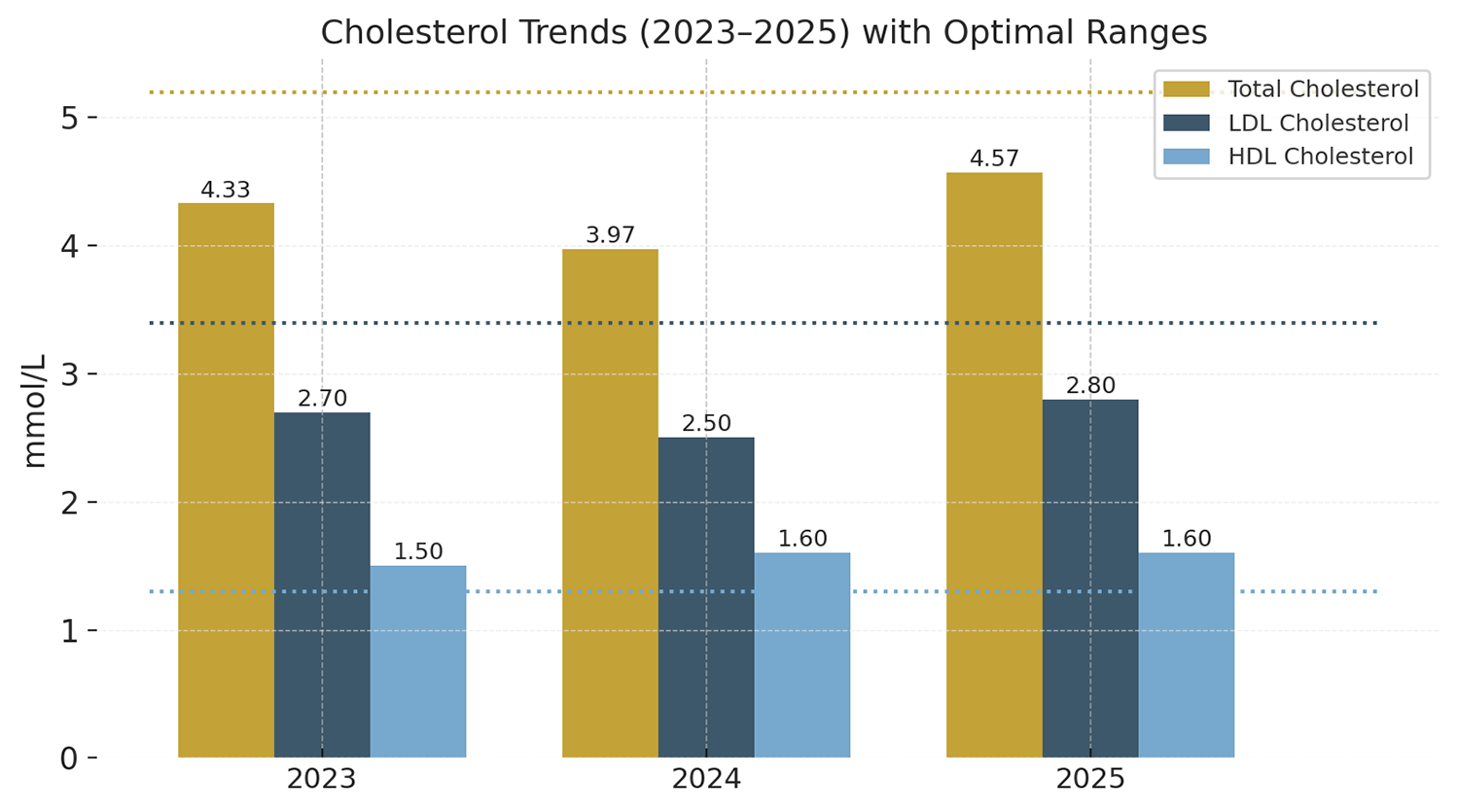What changed after 6 months of eating red meat again? My lab results
Looking back: why I gave up red meat—and why I brought it back
In my previous post, ‘Eating red meat again after 20 years’, I shared the personal and nutritional journey that led me to reintroduce red meat into my diet after two decades of abstaining. What began as an ethical decision to avoid it gradually evolved, especially as I began noticing lingering fatigue, borderline iron levels, and a growing desire to explore a more flexible, intuitive approach to eating.
I’m still only eating the occasional steak—no burgers, pork, or anything like that. On average, I’m having about 12 ounces (360 grams) of steak per month, and—dare I say—I’m actually starting to enjoy it. I order the organic sirloin minute steaks from Gazegill Organics, a family-run organic farm in Lancashire, England. (The Robinson family has managed the farm for nearly 500 years!!) The steaks are fresh and convenient, with two per pack, and they take just a few minutes to cook—I prefer mine pretty well-done. (And no, I’m not sponsored by Gazegill… I just genuinely love them.)
When Gazegill runs a sale, I place a bulk order for two months’ worth and freeze them right away. While I’m at it, I also stock up on their organic chicken carcasses and ox bones for bone broth—and now and then, I treat myself to some of their nutrient-rich raw milk. (Pasteurization destroys many of the natural enzymes and probiotics. Raw milk has been banned in Scotland since 1983 due to ‘public health concerns,’ but it's still legal to sell and ship in England. But that’s a blog post for another day.)
This past week I was way too excited to pour over my recent blood work analysis to see if reintroducing steak into my diet actually had a positive effect on my health. And the results are in!
My last post focused on mindset, history, and the emotional side of food choices. This post? It’s about the numbers.
Breaking down the results: what changed in my labs
Now that I’ve been eating small amounts of red meat for several months, I wanted to see what actually changed under the surface. Here’s a look at the most important lab markers—starting with iron.
Ferritin and hemoglobin: restoring iron stores
One of the biggest motivations for eating red meat again was to support my iron levels. For years, my ferritin—a marker of iron storage—had been drifting lower, and in mid-2024 it reached 31.6 ng/mL. While not dangerously low, it was heading toward depletion.
Just six months after reintroducing moderate amounts of red meat, my ferritin increased to 45.0 ng/mL. My hemoglobin also rose from 127 to 140 g/L, a meaningful improvement in oxygen-carrying capacity. You can see the shift clearly in the chart below:
What it means: Red meat's heme iron made a measurable difference. Fatigue improved, and lab markers confirmed that iron repletion was underway.
B12 and folate: staying strong
Alongside iron, vitamin B12 was a nutrient I monitored closely. Active B12 (holotranscobalamin) remained solid, increasing slightly from 103 to 112 pmol/L. Folate dropped modestly (from 18.9 to 13.7 nmol/L) but stayed well within the healthy range.
There were no signs of deficiency or imbalance—just a subtle reminder to continue eating a nutrient-diverse diet.
Thyroid: no disruption
My thyroid stimulating hormone (TSH) moved from 1.88 to 3.28 and back down to 2.49 mIU/L—well within the normal range throughout.
This was reassuring. There's often concern that dietary shifts can affect hormonal balance, but my lab test results showed stability.
Lipids: a slight rise, but still optimal
I’ve always had a good LDL-to-HDL cholesterol ration. This was one of the markers I was most curious (and a little nervous) about. Would adding red meat affect my heart health profile?
Here's how things changed:
Total cholesterol rose from 3.97 to 4.57 mmol/L by 2025. Still well below the 5.2 mmol/L threshold.
HDL (‘good’) cholesterol held strong at 1.6 mmol/L.
LDL (‘bad’) cholesterol rose slightly, from 2.5 to 2.8 mmol/L—again, under the 3.4 optimal mark.
I also created a more detailed breakdown by year with optimal ranges shown:
Bottom line: My cholesterol went up slightly, but all markers remain in the optimal range. Ratios are healthy. No red flags.
Inflammation: no signs of a flare-up
My inflammatory markers stayed consistently low:
CRP dropped from 1.14 to 1.06 mg/L.
hs-CRP held steady at 1.84 mg/L.
ESR was a healthy 16 mm/hr.
These numbers suggest that red meat did not trigger systemic inflammation.
Liver and kidney: stable and healthy
I also kept an eye on liver and kidney function:
ALT, AST, and ALP enzymes were all low and stable.
Creatinine rose slightly, but remained well within range (66 µmol/L by 2025).
Urea levels fluctuated but stayed normal.
No concerns here. My liver and kidney function were unaffected by dietary changes.
Final thoughts: red meat, reintroduced mindfully
Six months into eating red meat again, my lab results reflect what I was hoping for: improved iron status, steady B12, and stable markers across the board.
Red meat didn’t spike my cholesterol. It didn’t increase inflammation. It didn’t compromise kidney or liver function. It has given me more energy, stabilized my lab results, and reminded me that nutrition isn’t static.
Ready to rethink your relationship with food?
If you’ve ever questioned whether something you once gave up—like red meat—might actually support your health now, you’re not alone. Our bodies evolve, our needs shift, and sometimes the best thing we can do is re-evaluate our current ways of doing things.
Have you reintroduced a food after years without it? Or are you thinking about making a change but not sure how it will affect your health?
I’d love to hear your story. Drop a comment below, send me a message, or subscribe to follow along as I share more lab-backed wellness insights and real-life experiments.





